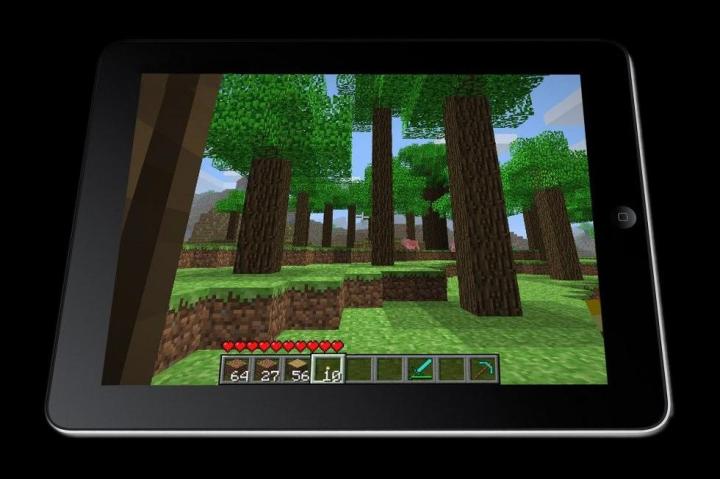
Two unexpected phenomena exploded in 2010. Both came out of seemingly nowhere, both gained traction almost immediately, and both remain popular to this day, elbowing out gigantic competitors and completely changing the perception of both consumers and peers. What pair of disruptive newcomers am I talking about? The iPad, and Minecraft.
At first glance, these seem to have nothing in common. One is a tablet, used to surf the Web, watch videos, and yes, play games – like Minecraft. The other is a game and; as such, it’s pure entertainment, less of a platform, and more of a pleasure.
Yet while these two entities are much different in purpose, they have some similarities in success. They arrived with minimal forewarning, were very different from anything that’d come before, and managed to build an enduring fan base in a category that was barely there before they arrived. Are these similarities just a coincidence, or is there a deeper connection?
Manipulating our world
Every child experiences a moment of epiphany early in his or her life. Suddenly, an idea begins to form: I can change the world! Once this idea forms, there’s no stopping it, and what follows is years of exploration through play.
Eventually, the child grows to be an adult, but the addiction to action never goes away. Picking up random objects and putting round pegs through round holes gives way to sports, arts, crafts, and other ways of expressing the power to act. Even the most famous past-times, like football (either global or American, take your pick), basically boil down to competition between teams to see which is better at moving an object.
Humans are hard-wired to take interest in anything we can directly interact with, and this almost universal compulsion is what makes both touchscreens and Minecraft so popular. Both of these very different experiences are about interacting with a virtual environment that responds directly to our real or virtual action.

Complexity through simplicity
An intuitive approach often results in accusations that a device or game has been dumbed down, and indeed, both the touchscreen devices and Minecraft have been criticized for their overt simplicity. Critics wonder what “the point” is, because while both offer the opportunity for exploration and creation, neither is the best tool for accomplishment. Few works of art or business plans have been finished on a tablet, and Minecraft is a game that can never really be finished.
What made both successful is not the end result they lead to, but the experience each offers. Both the iPad and Minecraft spurred revolutions because they provide direct interaction, which many users find to be more intuitive and more enjoyable. When you want to interact with an iPad, you touch it; when you want to interact in Minecraft, you walk up to a block and punch it. Direct action lays the foundation for understanding both.
And while the principle is simple, direct action can translate to surprising depth. Minecraft is an easy game (players literally cannot die in Creative mode), but players use it to make some truly impressive structures, including rudimentary computer processors and re-creations of mythical landmarks. Similarly, touchscreen devices like the iPad rely on just a few gestures, but they can still be used to edit photos, make movies, and communicate with friends. Complexity is possible because while the user’s actions don’t deviate from a few basic concepts, the context can be tweaked, making many things possible after mastering just a few principles.

Be direct, take over the world
Touch hasn’t rendered everything else obsolete, in the same way that Minecraft hasn’t wiped all other games from the face of the Earth. But intuitiveness made sudden popularity possible for both touch and Minecraft, and the example they set is clear: direct interaction is superior because it’s easier to use for more users.
Besides offering an opportunity for business, advances in touch and other technologies, such as motion tracking, are a boon for humanity. For those of us immersed in technology, it’s easy to forget that computing’s potential is outside the grasp of billions. The reasons for this are complex, but knowledge is at least one of them. Individuals can’t join the digital revolution with devices they don’t know how to use.
Sci-fi stories have long dreamed of direct interaction with virtual worlds, often via room-sized screens, or virtual reality headsets that can read brain patterns. But current touchscreen devices, and popular games like Minecraft, have proven that the ideas in fiction can be practiced today, to great success, on a smaller scale. In a few decades, children may look at pictures of computer mice in books, wondering with amusement at why anyone thought it’d be better to waggle a small, oval device than touch a screen or snap a finger. That’s a world we can, and should, aspire to live in because it’s a world where computing is easier for everyone to learn.
Editors' Recommendations
- Best iPad deals: Save on iPad Air, iPad Pro, iPad Mini for the New Year
- The best tablets in 2024: top 11 tablets you can buy now
- How to use your iPad as a second monitor for your Mac
- How to use Universal Control on Mac and iPad
- How to remove viruses and malware from your iPhone or iPad


